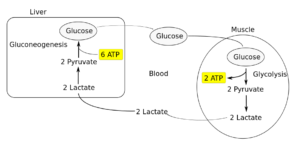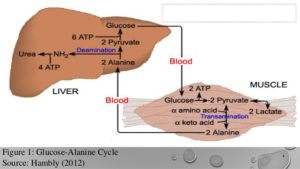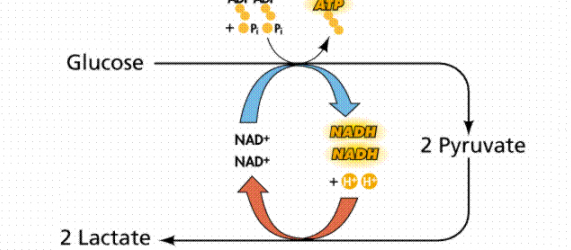Table of Contents
- Introduction
- Delayed onset muscle soreness
- Cramping
- Muscular acidosis
- Fatigue
- As fuel and in exercise
- Exercise Performance
- Conclusion
Introduction
Lactic acid has been unfairly demonized for everything from delayed onset muscle soreness to cramping to robbing banks. Well, maybe not robbing banks, but you get the point.
In this article we will dispel all myths about lactic acid, and cover physiologic explanations for the phenomena supposedly associated with lactic acid. If you have one that I have not covered please comment at the bottom of the article, and I will integrate it in later. This is the first post in a series on the metabolic pathways.
Delayed Onset Muscle Soreness
Contrary to popular belief, lactic acid is not responsible for delayed onset muscle soreness.
Delayed onset muscle soreness (DOMS) is caused by a couple factors. Exercise, especially eccentric exercise, creates microtrauma within the muscles. The body initiates an inflammatory response to repair the damaged area. There are a couple theories on how this produces DOMS, but none involve lactic acid.
- The inflammatory response itself may be responsible for aggravating afferent sensory neurons which would “cause” the pain associated with soreness.
- Microtrauma in the muscles allows ions to leak out into the surrounding musculature. This may also aggravate afferent neurons as many of these are ion sensitive. For example, neurons activate by firing action potentials which may be more easily set off by accumulated ion concentrations from the tears in the muscles.
- Enlarging of the area due to swelling and/or muscle growth may cause fascia stretching which may aggravate afferent neurons causing pain.
- Lactic acid is a metabolite not involved with any of the factors in delayed onset muscle soreness.
In fact, lactic acid is removed almost totally from the muscles within 30 minutes of cessation of exercise. How it could even begin to explain delayed onset muscle soreness which comes 24-72 hours later is beyond me.
Muscle cramping
Cramping occurs due to a few reasons.
- Impact/injury may cause cramping. What this means is if there is trauma to an area of the body, the body will generally tighten up to protect the area which thusly may cause cramping.
- Low blood flow. This may be due to already cramping muscles, too much scar tissue, or poor circulation. If there is very little blood flow to an area there is less oxygen. Less oxygen means poor metabolic functioning. If there is not enough oxygen to facilitate production of ATP, pumping of Ca2+ back into the sarcoplasmic reticulum cannot occur. This leads to sustained contraction of the muscle.
- Improper or overactive motor neuron function. Some diseases such as muscular (myoclonic) dystonia are caused by this. Similarly, twitching of random muscles may lead to cramping.
- Alternatively, cramps can also be due to overuse. Similarly to the low blood flow, we have a case where the muscle cannot keep up metabolically supplying the sarcoplasmic reticulum transporters with ATP to pump Ca2+. Thus, Ca2+ runs loose and initiates sustained contractions
- Electrolytic imbalances from intake of too many nutients or lack of nutrients also may contribute to cramping.
Apparently, loss of electrolytes does not cause cramps, especially from sweating during physical exertion.
Secondary cause may include poor range of motion. When muscles are moved into a short range of motion and contracted, they are likely to cramp. For example, the quads are likely to cramp if you try to do an L-sit or V-sit the first time you try. This goes back the poor blood flow scenario where a sustained contraction cuts off oxygen availability and the muscles cramp due to lack of ATP. People that are inflexible usually have tight musculature and lots of scar tissue already and are thus “predisposed” to poorer blood flow and easier cramping. Foam rolling, massage, and static stretching are musts.
As you can see, lactic acid is not involved with cramping. High quantities of it may be detected in severely oxygen limited muscle cells with diminished amounts of ATP. However, this is only a correlation and not the actual causation of cramping.
Note: the basis of massage and techniques such as ART/trigger points aim at releasing contracted muscles. This frees up blood flow for healing and ATP production as well as breaks up scar tissue and reintroduces inflammation to heal the prolonged damaged and contracted areas of muscle.
Muscular acidosis
Muscular and systemic acidosis is caused by three factors.
- ATP depletion: ATP + H2O -> ADP + P + H+
- Oxidation of glucose (C6H12O6) releases the hydrogen atoms as it is metabolized. Before the H+ ions get converted into H2O with oxygen at the end of the electron transport, they are released as H+ ions mostly in the krebs/citric acid cycle. All of the NADH generating reactions release H+.
2 NADH from Glycolysis + 1 (*2) NADH from Acetyl-CoA generation + 3 (*2) NADH from citric acid cycle generate 10 H+ per glucose molecule. The other two H+ are “absorbed” by FADH2 (QH2).
Hydrogen ions are buffered by microchondria through H+ ion gradients which drive the ATP synthase enzyme (this has very important implications which will be discussed later). ATP synthase is responsible for production of all ATP in the body by combining ADP + P and literally “smashing” them together to form ATP.
- CO2 in the blood combines with water.
CO2 + H2O -> HCO3- + H+
This drops pH. The body has monitors up near the heart to detect blood pH levels. If the pH of the blood drops, this tells the body that there is too much CO2 in the blood making it too acidic. Thus, we increase our inhalation and exhalation rate. Thus, we breath not because we need oxygen but because we need to exhale CO2.
- Incorrect: pyruvic acid + NADH -> NAD+ + lactic acid
Do NOT be confused here. Pyruvic acid –> lactic acid conversion does not release H+. Hence lactic acidosis is a misnomer and untrue because the pyruvate’s carboxylic acid group already has the hydrogen ion dissociated from it.
Muscular fatigue
There are a large number of reasons for decline and failure of contraction and peak tension in muscles. None are due to fatigue. Muscular acidosis is indeed one cause of fatigue; however, as we already examined lactic acid is not involved in “creating” muscular acidosis.
Similarly, other causes of fatigue may include (going down the chain): CNS, motor nerves not being activated, nerve impulses not being transmitted correctly through lack of ion gradient, depletion of neurotransmitters at the neuromuscular junction, actin/myosin or muscle damage especially in eccentric contractions, calcium dysregulation, lack of metabolic substrates, blood flow or oxygen leading to ATP depletion, etc.
Metabolically, the accumulation of lactic acid does usually signal that the body is fatiguing; however, it is not directly involved and may only be used as a measuring stick especially in anaerobic exhaustion.
Fuel?
Some “recent” articles in the media here and here have given the public an image that lactic acid is a fuel. This is semi-true. This is the Cori Cycle discovered in 1929 by the biochemists Carl and Gerty Cori.

Cori Cycle (image from wikiwand)
There are two lactate transporters, MCT1 and MCT4, involved with symporting lactate/H+ out of the muscle cells into the blood stream. These are transported as you can see in the image to the liver which metabolizes the lactate to glucose. Glucose is then shipped back to the muscle cells. The liver also releases glycogen stores as well. The alternative reaction that lactate can undergo within the muscle if exercise intensity decreases is that it can be reformed to pyruvate with NAD+ and then remetabolized into the citric acid cycle normally.
Thus, lactate is indeed a substrate used to resynthesize glucose. But saying it is a “fuel” itself is an stretch at best, and calling it new is certainly absurd. For more on the discovery of the Cori Cycle, see this article.
But wait…
The Cori Cycle is only one of the important “alternate” metabolic pathways in the body for resynthesis of glucose in the liver. The other is the Glucose-Alanine Cycle.

Glucose-Alanine Cycle (Image from slidesharecdn.com)
If oxidative metabolism is limited by the number of mitochondria, then excess pyruvate is converted into alanine from pyruvate and another amino acid. This leads to a dual interplay between the Cori Cycle (CC) and Glucose-Alanine cycle (GAC) which shifts the metabolic “debt” over to the liver. Since the GAC conserves NADH as opposed to the CC due to the pyruvate-lactate reaction (pyruvic acid + NADH -> NAD+ + lactic acid), the GAC allows more energy to be produced within the muscle because the NADH can be used to create 3 ATP in electron transport. This assumes, of course, that the intensity is not high enough that the extra NAD+ is needed for glycolysis.
We have both pathways playing off each other to send off substrates to the liver to help resupply glycogen to the muscles. If the intensity is higher, the Cori Cycle tends to be used a bit more. If the intensity is lower but above lactate threshold, the Glucose-Alanine Cycle is more prevalent. There is a mix of moderately-high intensity where both are used simultaneously. For more information see Exercise Biochemistry Page 220.
During exercise, excess lactate within the blood stream can be uptaken by the brain, heart, and slow twitch muscles as a source of energy besides being used by existing muscles. This is where the “lactate as fuel” argument comes from. I’ll let you decide for yourself if you consider it a fuel, or a network of vast metabolic interactions taking place on a grand scale. It’s created and consumed, but is not a primary source of energy as carbohydrates or fats are for the body; yet, it can be used for energy by the three above tissues.
Exercise Performance
The interesting thing about lactate is that it can be used to monitor sports performance now. It’s actually a better indicator of training than heart rate or other metrics because blood lactate levels are the most accurate in determining training intensity. In particular, finding the correct training level either sub-lactate, at-lactate, or above-lactate is critical in programming for elite athletes.
As you may know, going over the anaerobic threshold starts a lot of key physiological symptoms such as burning in the muscles where the body starts to produce lots of lactate as the muscles need more energy rapidly.
Modulating training intensity to the level of lactate in the blood can help both coaches and athletes know the precise levels at which they are training, so they can program exercises and rest effectively. I know for a fact that Olympic swimming and cycling teams already use this technology for their athletes.
Jan Ulbrecht’s book “The Science of Winning: Planning, Periodizing and Optimizing Swim Training” details his methodological research that has propelled the Dutch swimming team to double digit medals in the Olympics and world championships.
Of course, technology is still pretty expensive. As an example, BSXinsight’s sensor runs you over $300 for the cycling edition and over $400 for the multi-sport edition. Hopefully, as technology improves, it will drive the prices down.
Conclusion
In conclusion, we know that lactic acid does not cause DOMS, cramping, muscular acidosis, fatigue, and it is may be a “fuel source” although it may be used to resynthesize metabolites used for further production of energy. Lactate levels can be monitored in training to track precise performance metrics, which allows training to be dialed in for both novice and elite athletes.
Lactic acid is a metabolic byproduct of high intensity exercise. The fact that it correlates fairly well with the above symptoms and ailments does not mean it is a causative factor. Most laypeople and even medical and exercise physiology texts still follow “conventional wisdom” without fact checking their sources. The only way to combat the ignorance is with correct information.
Next time someone blames lactic acid for anything please set them straight.
This article was originally published November 4th, 2009 on Eat Move Improve. Updated Dec 2016.
Questions about articles may be addressed to the Overcoming Gravity reddit.
Author: Steven Low
Steven Low is the author of Overcoming Gravity: A Systematic Approach to Gymnastics and Bodyweight Strength (Second Edition), Overcoming Poor Posture, Overcoming Tendonitis, and Overcoming Gravity Advanced Programming. He is a former gymnast who has performed with and coached the exhibitional gymnastics troupe, Gymkana. Steven has a Bachelor of Science in Biochemistry from the University of Maryland College Park, and his Doctorate of Physical Therapy from the University of Maryland Baltimore. Steven is a Senior trainer for Dragon Door’s Progressive Calisthenics Certification (PCC). He has also spent thousands of hours independently researching the scientific foundations of health, fitness and nutrition and is able to provide many insights into practical care for injuries. His training is varied and intense with a focus on gymnastics, parkour, rock climbing, and sprinting. Digital copies of the books are available in the store.

